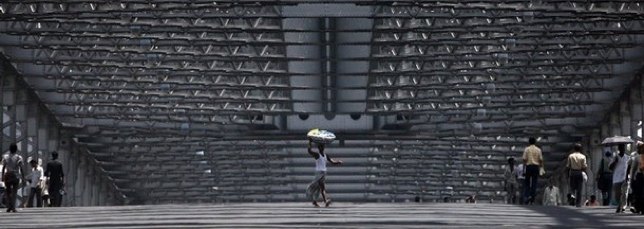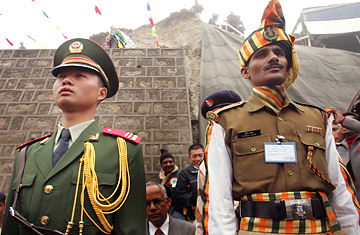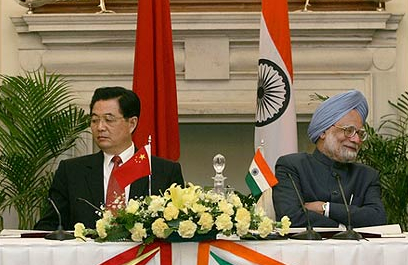Rivals and Partners: India and China Look Forward

This is the fourteenth in a series of articles that looks at China’s borders. As China has grown in the last 30 years, so have the often complicated relationships it has with its many varied neighbors. In this article, we take a look at India.
By Nazia Vasi
Sept. 15 – China and India, half of the world’s population, continue to move closer and closer to one another; but it’s often hard to tell whether the proximity will result in an embrace or a donnybrook.
When it comes to China-India relations, the two Asian behemoths have been playing the great game quite bashfully. They support each other on international fronts whether it’s to arm wrestle rich countries for farm subsidies at the WTO, hold regular high level diplomatic talks, conduct joint military exercises, fight terrorism or improve air and rail links, the lethal combination of India and China is a growing, commanding global force. However, the two countries often also like to indulge in a game of power tug of war, quarreling over land and sea territory, disagreeing on international relations, competing for international resources to fuel their rapid growth from Russian, African and Iranian oil, gas and natural resources and often viewing each other with an eye of suspicion.
History
Sino-India relations have never been so volatile before. Early relations between the neighboring countries chronicle the silk route which traded silks, spices, precious stones and much later Buddhism.
The transmission of Buddhism from India to China from the first century onwards, prompted many scholars and monks to travel between the two countries. Indian scholars Batuo from the Shaolin Monastery and Bodhidharna, the founder of Zen Buddhism traveled to China; while Chinese monks and scholars Xuanzang and I Ching attended Asia’s oldest residential university located in Bihar, India – Nalanda University.
Xuanzang later went on to write an account of his journey to India, which later inspired one of the four great Classical novels of Chinese literature, more popularly known in Mandarin as Xi You Ji or Journey to the West. During the time, China and India didn’t only exchange Buddhism and trade in goods, they also exchanged invaluable information – Aryabhatta, an Indian astronomer and mathematician’s works on trigonometry were translated into Mandarin.
During the 18th and 19th centuries, the strategically important border region became the frontline of the Great Game between Britain and Russia who struggled to gain control of the strategically important region. While the Russian’s pressed southward, the British in India buoyed by the Sikh confederacy invaded Tibet. The Chinese in retaliation fought and defeated the Sikhs and besieged Leh in Ladakh. At this point, neither side wished to continue the conflict, as the Sikhs were embroiled in tensions with the British that would lead up to the First Anglo-Sikh War, while the Chinese were in the midst of the First Opium War with the British East India Company. Consequently the Chinese and the Sikhs signed a treaty in September 1842, which stipulated no transgressions or interference in the other country’s frontiers.
Neighbors and rivals
 For the first half of the 20th century, although both China and India did not interact much, they concentrated on liberalizing themselves from the shackles of the past and focused on internal development.
For the first half of the 20th century, although both China and India did not interact much, they concentrated on liberalizing themselves from the shackles of the past and focused on internal development.
Sino-India relations began to mature in the 1950s, following the formation of the People’s Republic of China in 1949 and Indian Independence from the British in 1947. The initial bone of contention between the two developing, independent countries was Tibet. Because the two countries could not resolve their differences, in early 1954, China’s Zhou Enlai and India’s Jawaharlal Nehru signed the Panchsheel or five principles of peaceful coexistence, which include – mutual respect for each other’s territorial integrity and sovereignty, mutual non-aggression, mutual non-interference in each other’s internal affairs, equality and mutual benefit and peaceful co-existence.
However, relations quickly soured later that year when China and India both drew official maps including land the other country considered integral to them. Soon swords were drawn at the border, and in 1959 the Dalai Lama fled from Tibet to India, this was the final straw and in 1962, the Sino-Indian war commenced. While India lost the war, relations with the PRC further deteriorated through the rest of the 1960s and the early 1970s as China sided with Pakistan, India’s arch rival and India backed the Soviet Union, China’s prime enemy. Consequently the Nathu La Pass, the main artery through which China and Indian traded was sealed, disconnecting the two countries politically, culturally and economically.
Strengthening relationships
While the 1980s ignited a mix of diplomatic talks and a war like situation, the 1990’s sought to bond the estranged neighbors. Joint talks were held in India and China on the border issue, border trade resumed in July 1992 after a hiatus of more than thirty years and consulates reopened in Mumbai and Shanghai in December 1992, and in June 1993.
In 1993 and 1996, the two sides signed the Sino-Indian Bilateral Peace and Tranquility Accords, an agreement to maintain peace and tranquility along the Line of Actual Control (LoAC). Ten meetings of a Sino-Indian Joint Working Group (SIJWG) and five of an expert group have taken place to determine where the LoAC lies, but little progress has occurred. Recently, during the visit of Chinese Prime Minister to India, China recognized the territory of Sikkim and Assam as belonging to India, while India, during a visit by then Prime Minister Atal Behari Vajpayee, recognized the Tibet Autonomous Region as an autonomous part of China.
Through bilateral negotiations, the two establishments also signed several agreements on economic, scientific, cultural, technological, media and military cooperation, throughout the 1990s. One of the first forms of international entertainment then available to the Chinese was Indian Bollywood films, the best form of cultural connect between the two nations.
 The 21st century marked heightened Sino-Indian ties. The Nathula Pass was re opened and bilateral trade recently surpassed US$40 billion, bringing the two countries closer than ever on political, economic and cultural ties. Today, the economic strengths of both these countries is widely considered complementary – China is perceived to be strong in manufacturing and infrastructure while India is perceived to be strong in services and information technology. China is stronger in physical markets while India is stronger in financial markets.
The 21st century marked heightened Sino-Indian ties. The Nathula Pass was re opened and bilateral trade recently surpassed US$40 billion, bringing the two countries closer than ever on political, economic and cultural ties. Today, the economic strengths of both these countries is widely considered complementary – China is perceived to be strong in manufacturing and infrastructure while India is perceived to be strong in services and information technology. China is stronger in physical markets while India is stronger in financial markets.
Present day
Economic relations between the two countries are escalating. China is currently India’s largest trading partner. The two countries exchange steel, iron ore, technology, minerals and other raw materials. Initially, China and India had set a trade target of US$20 billion, which they reached two years before the target, buoyed by this optimistic trade the two governments upped their target of bilateral trade to US$40billion by 2010.
On the cultural front too, China and India have held several student, scholar, arts and tourism exchange programs. These bilateral ties between the two countries seek to further bridge the gap between the two nations, aiding them to better understand each other and work closer together.
High level diplomatic talks between the two countries are currently also at an all time high, Indian Prime Minister Manmohan Singh and president of India’s ruling Congress Party Sonia Gandhi have both officially visited China twice in this past year. Chinese ruling party leader Hu Jintao visited India in 2006, while Premiere Wen Jiabao visited India in 2005. During their bilateral meetings both countries have discussed the border issue and ways in which they can work towards a mutually beneficial cooperation.
China and India still have a long way to go in understanding each other. The countries may have suffered the same colonial past; but the rapid strides China has taken in its path to development ensure that the two countries are currently yet not politically, culturally or economically aligned.
As both countries grow, develop, learn more about each other and continue strong bilateral relations it will benefit not only their dealings, but also that of Asia.
This is the fourteenth in a continuing series that focuses on China’s borders. The complete series to date can be found here.
For more commentary on the emerging nations of Asia, please visit out sister website, www.2point6billion.com.
- Previous Article China and Pakistan’s Enduring Alliance
- Next Article China’s Investment Funds Assess Possible Losses Following Lehman Bankruptcy


























